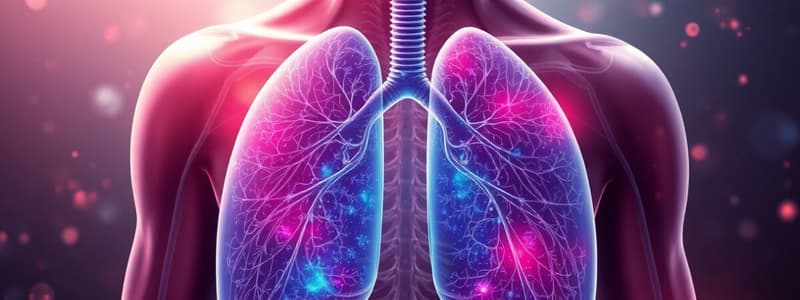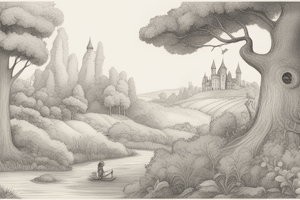Podcast
Questions and Answers
What is the primary function of the respiratory system?
What is the primary function of the respiratory system?
- To provide oxygen to the blood and remove carbon dioxide (correct)
- To transport nutrients throughout the body
- To facilitate digestion
- To regulate body temperature
What are the main components of the conducting division of the respiratory system?
What are the main components of the conducting division of the respiratory system?
- Alveoli and bronchioles
- Nostrils and larynx
- Nostrils through bronchioles (correct)
- Trachea and alveoli
During which process does gas exchange primarily occur in the respiratory system?
During which process does gas exchange primarily occur in the respiratory system?
- Inspiration (correct)
- Gas exchange occurs in both processes equally
- Expiration
- Gas exchange does not occur in either process
Which function is NOT associated with the nose?
Which function is NOT associated with the nose?
What structure divides the nasal cavity into right and left halves?
What structure divides the nasal cavity into right and left halves?
Which organ is part of the upper respiratory tract?
Which organ is part of the upper respiratory tract?
What is the primary function of the larynx?
What is the primary function of the larynx?
What is the function of alveoli in the respiratory system?
What is the function of alveoli in the respiratory system?
Which structure is responsible for the turbulence of air in the nasal cavity?
Which structure is responsible for the turbulence of air in the nasal cavity?
Which part of the nose is supported by nasal bones?
Which part of the nose is supported by nasal bones?
Which of the following does NOT describe a role of the respiratory system?
Which of the following does NOT describe a role of the respiratory system?
What is the purpose of the pleura surrounding the lungs?
What is the purpose of the pleura surrounding the lungs?
Where does air flow during expiration?
Where does air flow during expiration?
Which part of the pharynx is located behind the nasal cavity?
Which part of the pharynx is located behind the nasal cavity?
What is the structure called that guards the superior opening of the larynx?
What is the structure called that guards the superior opening of the larynx?
What type of cartilage is primarily found in the framework of the larynx?
What type of cartilage is primarily found in the framework of the larynx?
At which vertebral level does the trachea bifurcate into the right and left bronchi?
At which vertebral level does the trachea bifurcate into the right and left bronchi?
Which component of the respiratory system is primarily responsible for sound modulation during phonation?
Which component of the respiratory system is primarily responsible for sound modulation during phonation?
Which structure is a narrow air passage located beneath each nasal concha?
Which structure is a narrow air passage located beneath each nasal concha?
How many lobes does the right lung have?
How many lobes does the right lung have?
Flashcards
Respiration
Respiration
The process of taking in oxygen and releasing carbon dioxide, essential for energy production and removal of waste.
Respiratory System
Respiratory System
The primary organ system responsible for gas exchange, supplying oxygen to the blood and removing carbon dioxide.
Inspiration
Inspiration
The process of inhaling air into the lungs.
Expiration
Expiration
Signup and view all the flashcards
Alveoli
Alveoli
Signup and view all the flashcards
Conducting Division
Conducting Division
Signup and view all the flashcards
Respiratory Division
Respiratory Division
Signup and view all the flashcards
Upper Respiratory Tract
Upper Respiratory Tract
Signup and view all the flashcards
Lower Respiratory Tract
Lower Respiratory Tract
Signup and view all the flashcards
Nares
Nares
Signup and view all the flashcards
Nasal Conchae (Turbinates)
Nasal Conchae (Turbinates)
Signup and view all the flashcards
Meatus
Meatus
Signup and view all the flashcards
Pharynx (Throat)
Pharynx (Throat)
Signup and view all the flashcards
Larynx (Voice Box)
Larynx (Voice Box)
Signup and view all the flashcards
Epiglottis
Epiglottis
Signup and view all the flashcards
Thyroid Cartilage
Thyroid Cartilage
Signup and view all the flashcards
Cricoid Cartilage
Cricoid Cartilage
Signup and view all the flashcards
Glottis
Glottis
Signup and view all the flashcards
Trachea (Windpipe)
Trachea (Windpipe)
Signup and view all the flashcards
Bronchial Tree
Bronchial Tree
Signup and view all the flashcards
Study Notes
Respiratory System
- Breathing is fundamental to life, representing the first and last dramatic moments of human experience.
- Respiration is necessary because most metabolic processes directly or indirectly require ATP.
- ATP production requires oxygen and generates carbon dioxide.
- The respiratory system primarily transports air to the lungs for gas exchange.
- Oxygen diffuses into the blood, and carbon dioxide diffuses out.
Main Function
- The respiratory system is a specialized organ system that provides oxygen to the blood and removes carbon dioxide.
- It has additional functions like smell and speech.
- It also regulates blood pressure and is involved in expelling abdominal contents.
Respiratory Tract
- Upper Respiratory Tract Parts:
- Nose
- Mouth
- Pharynx
- Larynx
- Lower Respiratory Tract Parts:
- Trachea
- Bronchi (right and left)
- Bronchioles
- Alveoli
- The respiratory system is a pathway for air that branches into the lungs, where gas exchange occurs.
Lungs
- They have three surfaces for ventilation:
- Diaphragmatic surface
- Costal surface
- Mediastinal surface
- The lung root contains structures like the main bronchus, blood vessels, and nerves.
Pleura
- The pleura is a two-layered membrane around the lungs.
- The visceral pleura directly covers the lungs.
- The parietal pleura lines the thoracic cavity.
- A fluid-filled space between the membranes reduces friction during breathing.
Studying That Suits You
Use AI to generate personalized quizzes and flashcards to suit your learning preferences.




